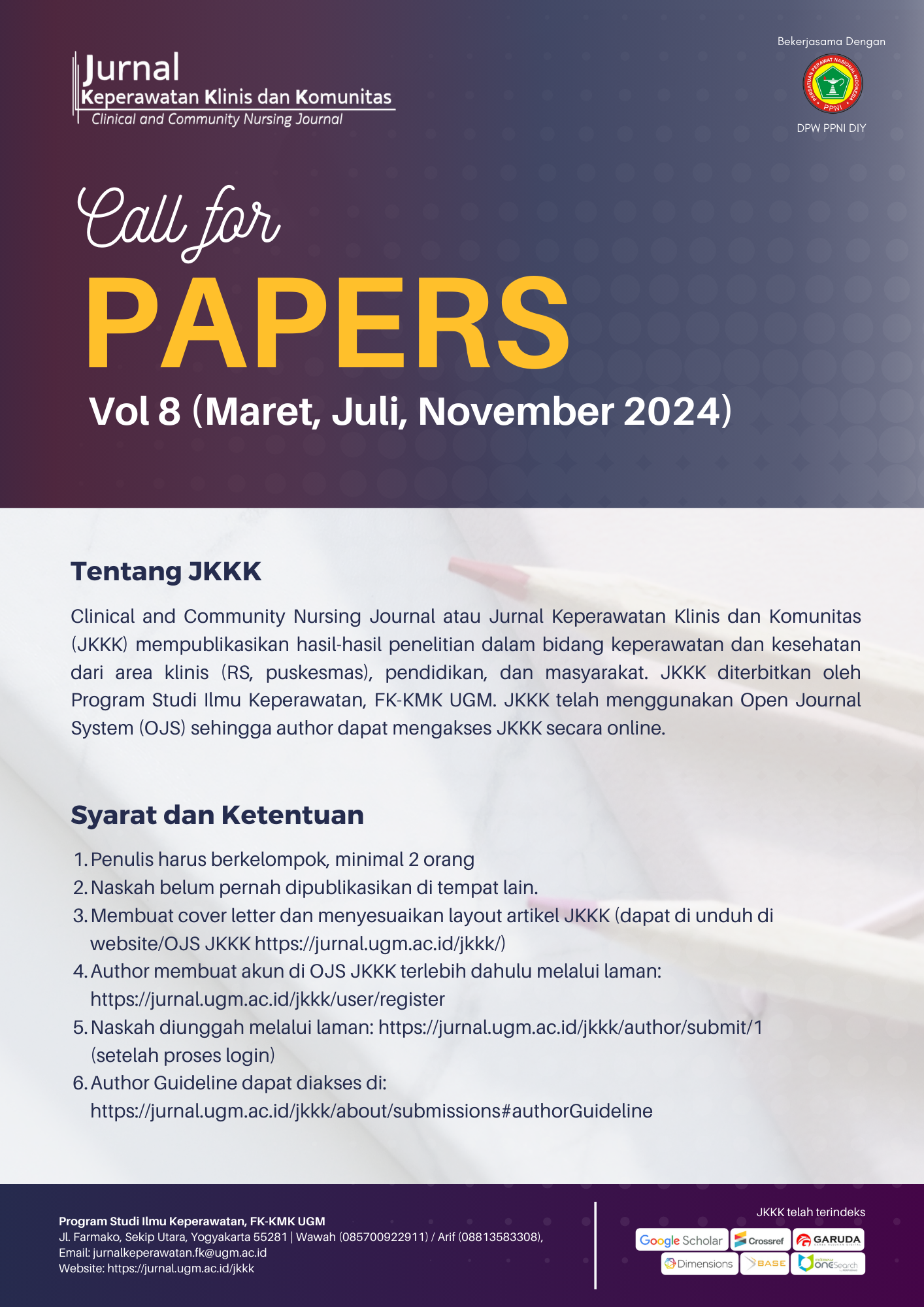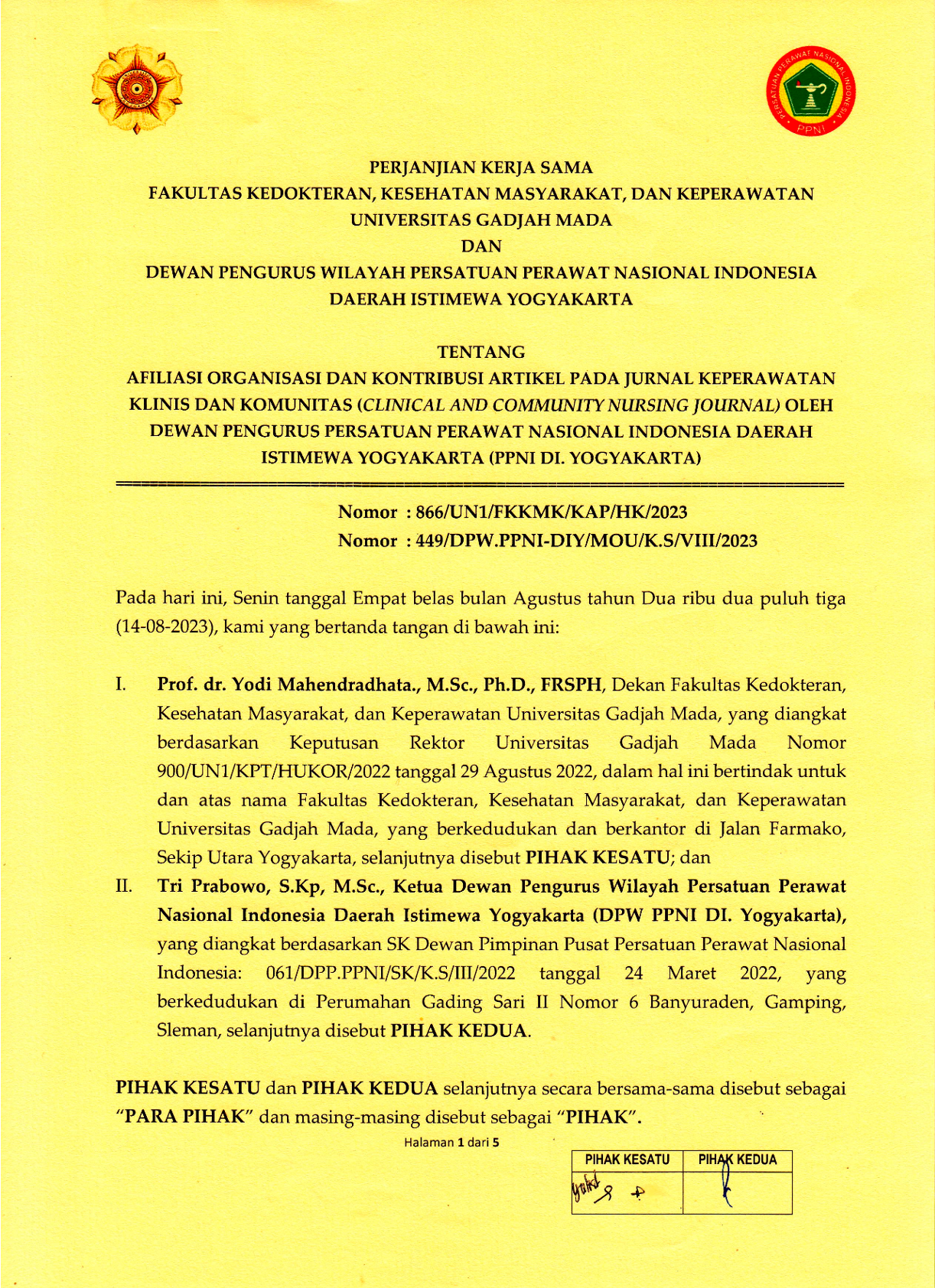Resusitasi Jantung Paru Menggunakan Feedback Device Terhadap Kualitas RIP pada Peserta Pelatihan RJP Mahasiswa S1 Keperawatan Tahap Profesi di Yogyakarta
Fifi Dwi Andika(1*), Sutono Sutono(2)
(1) Program Studi Ilmu Keperawatan, Fakultas Kedokteran, Universitas Gadjah Mada, Yogyakarta
(2) Departemen Keperawatan Dasar dan Emergensi, Fakultas Kedokteran, Universitas Gadjah Mada, Yogyakarta
(*) Corresponding Author
Abstract
Background: Cardiopulmonary resuscitation (CPR) training is one way to improve the quality of CPR itself. However, in developing countries there has been no unified method of CPR that causes nursing graduates to have different skills of CPR. One of the recommendations for learning CPR by American Heart Association (AHA) in 2010 is a CPR demonstration using feedback device. However, some previous researches have pointed out that no consistent results were found about the effect of feedback device on the quality of skill of CPR.
Objective: To determine whether a demonstration of CPR with feedback device affects the quality of CPR among nursing interns as CPR trainees in Yogyakarta.
Methods: This was a pre-experimental study using one group pretest-posttest design. There were one research group, 1 time pretest and 1 time posttest. The study population was 13 undergraduate nursing students at the internship stage in Yogyakarta who were registered as participants in CPR training. Samples were taken by using saturation sampling technique which then obtained a sample size of 13 people. Data were analyzed using the Wilcoxon test.
Results: CPR using feedback devise influence the CPR quality in term depth compression (p=0,006) and total number of ventilation (p=0,014) but not influence others component such as average of depth compression, rate of compression, wrong hand position, incomplete release, average volume of ventilation and duration of session.
Conclusion: There was no influence of CPR demonstration using feedback device on the quality of CPR among nursing interns in Yogyakarta.
ABSTRAK
Latar Belakang: Pelatihan RJP merupakan salah satu cara untuk meningkatkan kualitas RJP. Namun, di negara berkembang belum terdapat metode demonstrasi RJP yang seragam sehingga lulusan yang dihasilkan pun berbeda-beda. Salah satu rekomendasi edukasi RJP oleh American Heart Association (AHA) pada tahun 2010 adalah metode demonstrasi RJP menggunakan feedback device. Beberapa penelitian sebelumnya tidak menunjukkan hasil yang konsisten tentang pengaruh feedback device terhadap kualitas RJP.
Tujuan: Untuk mengetahui apakah demonstrasi RJP menggunakan feedback device berpengaruh terhadap kualitas RJP pada peserta pelatihan RJP mahasiswa S1 keperawatan tahap profesi di Yogyakarta.
Metode: Penelitian ini merupakan penelitian pre eksperimental one group pre-test-post-test. Pada penelitian ini terdapat 1 kelompok penelitian, 1 kali pre-test, dan 1 kali post-test. Populasi penelitian adalah mahasiswa keperawatan S 1 tahap profesi di Yogyakarta yang terdaftar sebagai peserta pelatihan RJP, yaitu 13 orang. Penentuan sampel menggunakan sampling jenuh yang kemudian didapatkan sampel sebesar 13 orang. Data dianalisis menggunakan Wilcoxon.
Hasil: RJP menggunakan feedback device memberikan pengaruh terhadap kualitas RJP dalam hal kedalaman kompresi (p=0,006) dan total jumlah ventilasi (p=0,014). Sementara RJP menggunakan feedback device tidak berpengaruh pada kualitas indikator kompresi dan ventilasi lainnya (rata rata kedalaman, kecepatan kompresi, posisi tangan yang salah dan pelepasan yang tidak lengkap, rata rata volume ventilasi dan durasi ventilasi).
Kesimpulan: Tidak terdapat pengaruh demonstrasi RJP menggunakan feedback device terhadap kualitas RJP pada peserta pelatihan RJP mahasiswa S1 keperawatan tahap profesi di Yogyakarta.
Keywords
Full Text:
PDFReferences
Noncommunicable Diseases CountryProfiles 2011. WHO.2011.1-207. doi:10.2471/BLT.07.045138
Part 5: Adult basic life support: 2010American Heart Association Guidelines forCardiopulmonaryResuscitationandEmergencyCardiovascular Care Circulation, 2010. 122.doi:10.1161/CIRCULATIONAHA.110.970939
European Resuscitation CouncilGuidelines for Resuscitation 2010 Section1. Executive summay.Resusctator . 2001:81:1219-76.doi:10.1016/j.resuscitation.2010.08.021
Sutton RM, Heather W, Nishisaki A, Leffelman J, Niles D, Meaney PA, danNadkarni VM. Pushing harder, pushing faster,minimizing interruptions...But falling short of2010 Cardiopulmonary resuscitation targetsduring in-hospital pediatric and adolescent Resuscitation. 2013:84: 1680-4.
Part4:CPRoverview:2010AmericanHeartAssociation Guidelines for CardiopulmonaryResuscitation and Emergency CardiovascularCare. Circulation, 2010b;122:676-85. doi:10.1161/CIRCULATIONAHA.110.970913
Meaney PA, Bobrow BJ, Mancini ME,Christenson J, De Caen AR, Bhanji F, Leary Cardiopulmonary resuscitation quality:Improving cardiac resuscitation outcomesboth inside and outside the hospital: Aconsensus statement from the American heartassociation. Circulation, 2013; 128:417-35.doi:10.1161/CIR.0b013e31829d8654
Highlights of the 2010 American HeartAssociation Guidelines for CPR and ECC.Resuscitation. 2010.
Cason CL, Trowbridge C, Baxley SM, & Ricard A counterbalanced cross-over study ofthe effects of visual, auditory and no feedbackon performance measures in a simulatedcardiopulmonary resuscitation. BMC Nursing,2011:10,15. doi:10.1186/1472-6955-10-15
Yeung J, Davies R, Gao F, & Perkins GD.A randomised control trial of prompt andfeedback devices and their impacton qualityof chest compressions-A simulation study.Resuscitation,2014;85(4):553-9. doi:10.1016/j.resuscitation.2014.01.015
Zapletal B, Greif R, Stumpf D, Nierscher FJ,Frantal S, Haugk M, Fischer H. Comparingthree CPR feedback devices and standardBLS in a single rescuer scenario: Arandomised simulation study. Resuscitation,2014;85(4):560-66. doi:10.1016/j.resuscitation.2013.10.028
Spooner BB, Fallaha JF. Kocierz L, Smith CM,Smith SCL, Perkins, GD. An evaluation ofobjective feedback in basiclife support (BLS) Resuscitation journal, 2007:Vol73(3):417-424.
Foo NP, Chang JH, Lin HJ, Guo HR. Rescuerfatoque and cardiopulmonary resuscitationpositions: A randomized controlled crossoverResuscitationjournal,2010:Vol81(5):579-584.
Ozdemir A, Akansel N & Tunk G. Gender andcareer: Female and male nursing students,perceptions of male nursing role in Turkey.Health Science Journal,2008;2(3):133-61.
Kouta C & Kaite CP Gender Discriminationand Nursing: A Literature Review. Journalof Professional Nursing, 2011;27(1):59-63.doi:10.1016/j.profnurs.2010.10.006
Al-zein HJ, & Al-khawaldeh OA. GenderRole Identity Among Jordanian Male NursingStudents : A Descriptive Study.EuropeanScientific Journal, 2015;11(17):338-49.
McKenna L, Vanderheide R, & Brooks I.Is graduate entry education a solution toincreasing numbers of men in nursing?NurseEducation in Practice. 2015. doi:10.1016/j.nepr.2015.11.007
Peberdy MA, Silver A, & Ornato JP. Effect ofcaregiver gender, age, and feedback promptson chest compression rate and depth.Resuscitation 2009;80(10):1169-1174.doi:10.1016/j.resuscitation.2009.07.003
GoodpasterBH,ParkSW,HarrisTB,KritchevskySB, Nevitt M, Schwartz AV, The Loss ofSkeletal Muscle Strength,Mass, and Qualityin Older Adults : The Health, Aging and BodyComposition Study, 2006;61(10):1059-64.
Gongalves PMD, Maifrino LBM, & Gama EF.Morphological changes caused by aging onskeletal muscles and effectsof exercise:a literature review. J. Morphol, 2010;27(3-4):117-20. Retrieved from http://jms.org.br/v27n3-4/01
Nilwik R, Snijders T, Leenders M, Groen BBL,van Kranenburg J, Verdijk LB, & Van Loon The decline in skeletalmuscle masswith aging is mainly attributed to a reductionin type II muscle fiber size. ExperimentalGerontology,2013;48(5):492-8.doi:10.1016/j.exger.2013.02.012
Jaafar A. Abdulwahab M, & Al-hashemi E.Influence of Rescuers ’Gender and Body MassIndex on Cardiopulmonary Resuscitationaccording to the American Heart Association2010 Resuscitation Guidelines. InternationalScholarly Research Notices, 2015;5.
Truszewski Z, Szarpak L, KurowskiA, Evrin T, Zasko P, Bogdanski L. & Czyzewski L. Randomized trial of the chest compressions effectiveness comparing 3 feedback cardiopulmonary resuscitation devices and standard basic life support by American Journal of Emergency Medicine, 2016;34(3):381-5. doi:10.1016/j.ajem.2015.11.003
Idris AH, Guffey D, Aufderheide TP, Brown S, Morrison LJ, Nichols P. Davis D. The relationship Between Chest Compression Rates and Outcomes from Cardiac Arrest, 2013 ; 125( 24 ) : 3004-12.doi:10.1161/CIRCULATIONAHA.111.059535.
Nolan JP, Perkins GD, & Soar J. Chest Compression Rate: Where Is the Sweet Spot? Circulation,2012; 1(25):2968-70. doi:10.1161/CIRCULATIONAHA.112.11272.
Buleon C, Parienti JJ, Halbout L, Arrot X, De Facq Regent H, Chelarescu D, Hanouz JL. Improvement in chest compression quality using a feedback device (CPR meter): A simulation randomized crossover study. American Journal of Emergency Medicine, 2013;31(10):1457—61. doi:10.1016/j.ajem.2013.07.029
Fischer H, Gruber J, Neuhold S, Frantal S, Hochbrugger E, Herkner H, Greif R. Effects and limitations of an AED with audiovisual feedback for cardiopulmonary resuscitation: A randomized manikin study. Resuscitation, 2011;82(7):902-907. doi:10.1016/j.resuscitation. 2011.02.023
Reddy K, Murray B, Rudy S, Moyer J, & Sinz Abstract 224: Efffective Chest Compressios Are Related to Gender and Body Mass Idex. Resuscitation Science Symposium Abstracts.2011.
Sayee N, & McCluskey D. Factors influencing performance of cardiopulmonary resuscitation (CPR) by foundation Year 1 Hospital Doctors. Ulster Medical Journal, 2012;81(1):14-8.
Beesems SG, & Koster RW. Accurate feedback of chest compression depth on a manikin on a soft surface with correction for total body displacement. Resuscitation, 2014;85(11):1439-43.doi:10.1016/j. resuscitation.2014.08.005
LeeS,Oh J,Kang H, LimT,Kim W, Chee Y, ChoJ H. Proper target depth of an accelerometerbased feedback device during CPR performedon a hospital bed: a randomized simulation The American Journal of EmergencyMedicine,2013;33(10):1425-9. doi:10.1016/j.ajem.2015.07.010
Kern KB, Stickney RE. Gallison L,& Smith RE. Metronome improvescompression and ventilation rates duringCPR on a manikin in a randomized trial.Resuscitation,2010 ; 81( 2 ):206-210.doi:10.1016/j.resuscitation.2009.10.015
Niles D, Nysaether J, Sutton R, NishisakiA, Abella BS, Arbogast K, Maltese M.R, BergRA, Helfaer M, Nadkarni V. Leaning iscommon during in-hospital pediatric CPR,and decreased with automated corrective Resuscitation 2009;80:553-7.
Zou Y, Shi W, Zhu Y, Tao R, Jiang Y, LiS,Tong J. Rate at 120/min provides qualifiedchest compression during cardiopulmonary American Journal of EmergencyMedicine,2015; 33(4):535-8. doi:10.1016/j.ajem.2015.01.024
Oh JH, Lee SJ, Kim SE, Lee KJ, Choe JW,& Kim CW. Effects of audio tone guidanceon performance of CPR in simulated cardiacarrest with an advanced airway. Resuscitation,2008;79(2):273-7.doi:10.1016/j.resuscitation.2008.06.022
Chung TN, Kim SW, You JS, Cho YS, ChungSP, Park I, & Kim SH. The specific effectof metronome guidance on the quality ofone-person cardiopulmonary resuscitationand rescuer fatigue. Journal of EmergencyMedicine, 2012;43(6):1049-54.doi:10.1016/j.jemermed.2012.01.021
Mclnnes AD, Sutton RM, Orioles A, NishisakiA, Niles D, Abella B S, Nadkarni V. The firstquantitative report of ventilation rate duringin-hospital resuscitation of older children and Resuscitation, 2011;82(8):1025-9.doi:10.1016/j.resuscitation.2011.03.020
Nikolla D, Lewandowski T, & Carlson Mitigating hyperventilation duringcardiopulmonary resuscitation. The AmericanJournal of Emergency Medicine, 2015:3-6.doi:10.1016/j.ajem.2015.11.070
Souchtchenko SS, Benner JP, Allen JL, &Brady WJ. A review of chest compressioninterruptions during out-of-hospital cardiacarrest and strategies for the future. Journalof Emergency Medicine, 2013;45(3):458-66.doi:10.1016/j.jemermed.2013.01.023
Cunningham LM, Mattu A, O’Connor RE, &Brady WJ. Cardiopulmonary resuscitationfor cardiac arrest: The importance ofuninterrupted chest compressions in cardiacarrest resuscitation. American Journal ofEmergency Medicine. 2012;30(8):1630-38. doi:10.1016/j.ajem.2012.02.015
Tschan F, Vetterli M, Semmer NK, Hunziker S, & Marsch SCU. Activities during interruptions in cardiopulmonary resuscitation: A simulator study. Resuscitation,2011;82(11):1419-23. doi:10.1016/j.Resuscitation.2011.06.023
Article Metrics
Refbacks
- There are currently no refbacks.
Copyright (c) 2017 Fifi Dwi Andika, Sutono

Jurnal Keperawatan Klinis dan Komunitas (Clinical and Community Nursing Journal)
collaborates with DPW PPNI DIY
![]()
Jurnal Keperawatan Klinis dan Komunitas (Clinical and Community Nursing Journal) is licensed under a Creative Commons Attribution-ShareAlike 4.0 International License.




